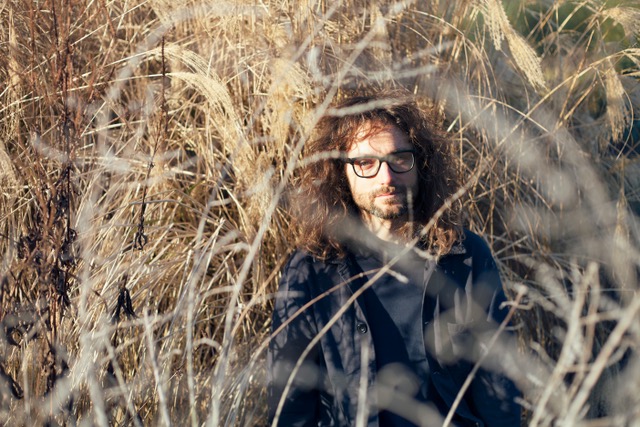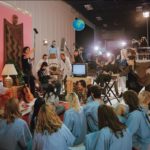Casually Here released his new album Possible Worlds last month. Forging a tapestry of ambient sounds, dextrous beats and subtle electronic textures. Casually Here (AKA Nic Nell) is an artist, composer, sound designer and producer/engineer with a background in art and mathematics.
Possible Worlds features seven sprawling tracks explore possible futures at this precarious point in history, all whilst clinging onto hope. The record explores these themes with acoustic and electronic instruments, analogue hardware, field recordings and sound design, using modern studio tools to push the sonic boundaries of both the dancefloor and home-listening.
Written, performed, produced and mixed by Nell himself, Possible Worlds was mastered and cut by Guy Davie (Jon Hopkins, Bibio, Nathan Fake etc). Below, he talks us through the record track by track.
Pale Blue Dot
‘Pale Blue Dot’ references Voyager 2’s famous photo of the Earth as a distant pinprick of light, taken through the rings of Saturn as it swept out of the solar system.
It emerged almost complete in a day, and it was only listening back to it before bed that I thought, oh, I might have made something there. I had swapped studios with Duncan Toothill (Lawrence Hart) for the day, and he had just been given a beautiful piano by his old piano teacher. Liam Hutton’s mum, sound designer Jo Hutton’s old Oberheim OB-Xa was in the studio which has a slightly loopy sounding glide function which I used for the synth slides counterpoint to the main piano.
There was an incredible microphone as one of the two piano mics which I swung round to record some bongos and a hi hat I’ve ended up using across lots of records. There was a Teenage Engineering Pocket Operator drum machine which I recorded a bunch of takes playing around with. I built up the skittery noises in the groove by resampling rim hits through a delay that slowly changes delay time on both sides/where the skitters fall in the groove, which does something interesting to the brain against the bongos. The second verse evokes images of orbiting heavenly bodies and swinging up through Saturn’s rings which I leant into in the spatial sound design.
The almost ambient outro sections of the song were quite a weird experience to make as it felt as if I was just leaning on the piano and all this lovely stuff was coming out as if by magic – I felt almost like an actor pretending to play the piano like they pretend to drive a car in a movie swinging the wheel left and right. It was surreal.
Apex
Apex is the spiritual and emotional centrepiece of the album and was inspired by a transcendent experience I had on the dancefloor during a Jon Hopkins DJ set. My aim was to try to evoke the feelings of collective optimism and joy of not only being a part of greater humanity, but of being an interconnected part of all life on Earth, whilst placing us within the wider context of deep time, from our evolutionary origins to a hopeful future. So not ambitious at all!
The track starts with guitar harmonics made into drones with Juno lead notes which evoked an image of a big burnt orange sun through the heat haze of the day, so I let that image be my jump off point.
I tried to capture some of the dusty physicality of the real world with a bit of a tumble in the drums and recorded loads of live percussion layered with loops of field recordings I made of things like fire and the sea.
At the peaks there is a lead Minibrute synth that sounds like roaring big cats and, in my mind’s eye, evokes the world of Henri Rousseau’s painting ‘Tiger In A Tropical Storm’. I tried to capture that vividness musically as a dense, jungly rich tapestry, always moving and changing.
The drop out section is the moment of transcendence with voices and choirs coming in to ground us with a human connection. The sound design has all sorts going on like a fidget spinner recorded through delays and even dolphin cries.
Right at the end we’re left with a sense of Savannah wide calm which I hear as long grass blowing in the wind.
Crickets
Crickets opens with a recording I made in the middle of the night in Liwonder in Malawi, when I woke up and found myself amongst this incredible complex soundfield from all sides.
The groove started by accident whilst looking at another track I was working on which Duncan Toothill had improvised some piano on the end of. At some point I got distracted whilst playing with that track and Ableton started looping on a piano stab with a clip of the spoken dialogue at the end of the project, and whilst not really paying attention to it, my brain started hearing it as a piece of music.
I wanted all the rhythmic stuff to feel a bit like the complex real world sound and cross rhythms of all the life in the background. There was an aircon unit in the studio above the desk which occasionally slightly terrifyingly started dramatically dripping water… so some of that made it into the drums both at pitch and slowed down along with jangling keys, jacaranda pods and recordings of my field recorder being turned on and off. There’s also a marimba I recorded in the Museum Of Malawi in there.
In the middle of the track there’s a drop to total ambient stillness. I wanted the ear to become accustomed to everything that’s going on so that when all the drums suddenly drop away – we’re left with a feeling of calm and almost quiet, as if we have dropped away to nothing despite the fact that there is actually still lots of sound in there – we’ve just become accustomed to the field recordings in the background so – like in our day to day life, we’ve tuned them out.
A 2067
This is the dark dystopian surveillance AI track on the album and evokes images of dense, dark rainy Blade Runner like cities for me. The name refers to one of many possible 2067s there might be.
The metallic crashing noises in the drum groove are recordings of me kicking the desk in the studio which had this big clattery metal panel on the back of it. I think I must have accidentally kicked it when I was starting the beat and it really kicked off the direction and tone of the track, in contrast to the woodier drums sounds on other tracks on the album.
I love the super digital sweeps in the middle and end which I made using a Boss DD-6 digital delay pedal playing with high feedback and super short delay times. They sound super HD and pristine rather than like something that came out of a guitar pedal yet have some wild unpredictability in them as I had to physically do the sweeps using the tiny knobs to try and wrangle the time and feedback without the feedback going exponential.
The Great Filter
‘The Great Filter’ is named in reference to the Fermi Paradox. It started with some chords on the Prophet 08 which are still in there somewhere but ended up sitting back pretty far. The tight, pingy almost metallic delays on the drums were inspired by Lanark Artefax’s brilliant ‘Touch Abstinence’. The synth bassline then seemed to will itself into existence fully formed – as if it was a solid object that already existed in the world.
It was a bit of a wrangle dealing with all the phased frequency rub washy stuff in the mix, but it felt like that allowed for the directness/playfulness of the bass. Sometimes the problem elements are part of what makes something work and if you clean everything up too much you lose the magic which is somewhere in the folds.
The outro section features a ring pull from an Aldi tin of mackerel making the beautiful crystalline plinking sounds. One must have broken off a tin and when I then dropped it on the desk it made a wonderfully musical sound which I recorded dropping many times. As the track fades out I slowed down the recordings to drop the pitch.
If you haven’t come across the Fermi Paradox/idea of the Great Filter then I heartily recommend a search/Wikipedia dive. (https://en.wikipedia.org/wiki/Great_Filter). We don’t know whether we’ve passed the Great Filter as a species or whether it still lies ahead, but here’s to raising a glass to the trillions that might come if we don’t screw this up!
Rhubarb Skies
‘Rhubarb Skies’ emerged in a two and half hour blast on a Saturday afternoon. It was initially a rather polite sounding piano piece before slowing the midi down to half the speed I had played it at, and changing the piano to a sample instrument made out of the only individual note I had from the piano recordings of Pale Blue Dot (note to self – record some individual notes when recording a piano in case you’re missing some later!). This totally changed the character of the piece and as I didn’t replay it at the slower speed, the slight timing variations accentuate the languid feel. As it was just one piano note recorded – there was a lot of physical piano noise on it so I did have to wrangle some of that as all the noise was repitched on every note which adds something of a prepared piano feel to it.
For the outro section I played a descending synth part and then resampled clarinet trills through a delay. I then placed and crossfaded them visually with both the sound and grid off, and then just hit render as I wanted to escape the studio. Those are the edits that appear in the final song which is part of what gives it this lovely natural/organic, slightly unpredictable relaxing feel. Those trilling clarinets evoke images of wheeling flocks of flamingos for me, surreally nesting high up in the ice lakes of the Bolivian Altiplano.
Fête
This is humanity looking back at life on earth/the full life cycle of humanity as a species in its autumn days – a bit like a feast back at Hobbiton at the end of the Lord Of The Rings, where hopefully we’re looking back and reflecting on having done a good job of it and thinking ‘right what’s next…’.
The build of the track sounds like it’s constructing itself, which I love, until it breaks into a brief requiem with a touch of sound of the Radiohead’s ‘Motion Picture Soundtrack’ organ to it but done with my old melodica layered with clarinets.
I hear the zipping electronic sounds at the end as our digital ancestors/descendents/AIs/posthumans in some kind of drone form, observing and zooming around.
I like the starts and ends of albums to feel like steps on a journey so this ends with a foot ready to take another step onwards, just as it started, with our eyes on the horizon.




